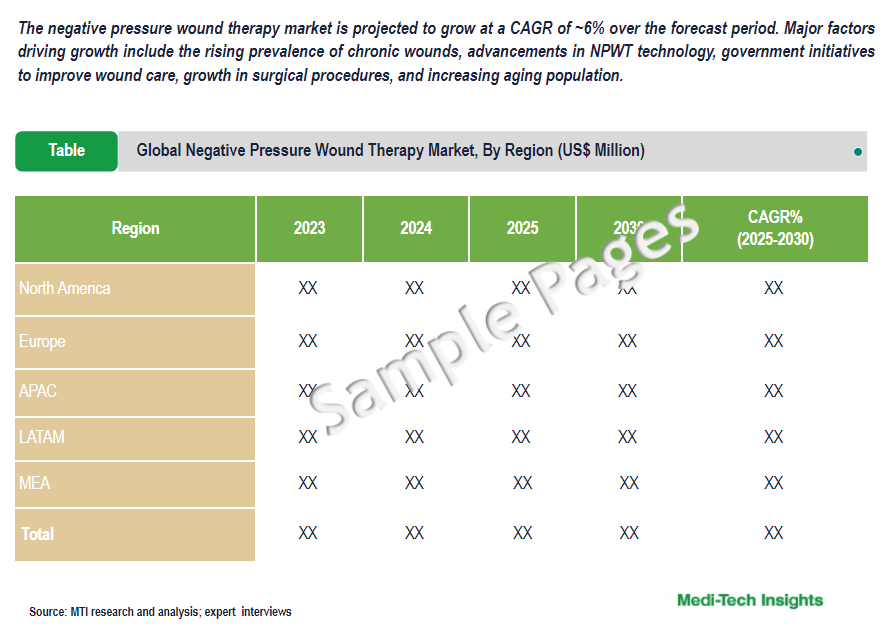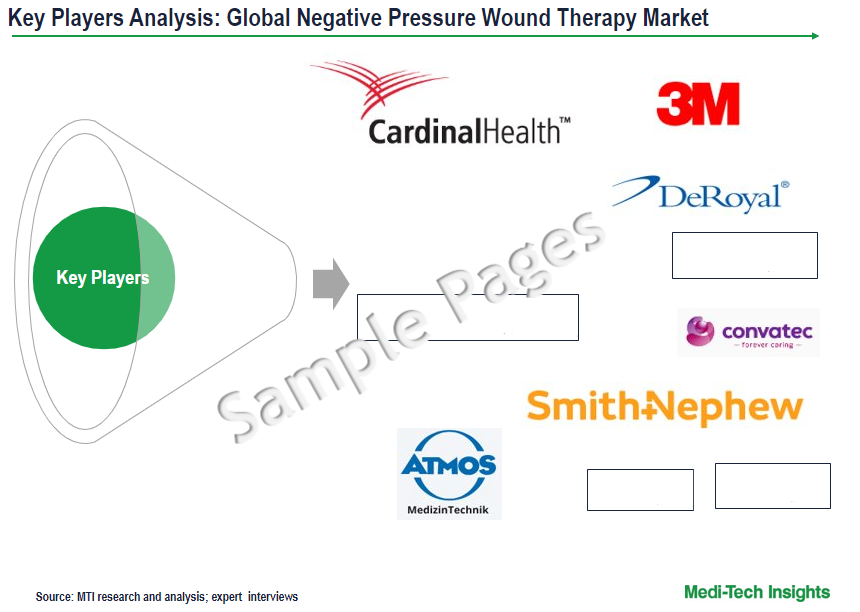
Global Negative Pressure Wound Therapy Market Size & Trends Report Segmented by Product (Conventional NPWT Devices, Disposable NPWT Devices), Wound Type (Traumatic Wounds, Diabetes Foot Ulcers, Pressure Ulcers), Forecasts to 2030
The negative pressure wound therapy market is projected to grow at a CAGR of ~6% over the forecast period. Major factors driving growth include the rising prevalence of chronic wounds, advancements in NPWT technology, rising occurrences of accidents, injuries, and burns globally, government initiatives to improve wound care, growth in surgical procedures, and an increasing aging population. However, complications associated with negative pressure wound therapy are expected to hamper market growth. To learn more about the research report, download a sample report.
Report Overview
Negative pressure wound therapy (NPWT), also known as vacuum-assisted wound closure, involves the use of specialized wound dressing systems that apply subatmospheric pressure, either continuously or intermittently, to a wound's surface to promote healing. This therapy helps remove excess fluids, reduce swelling, and stimulate tissue regeneration. This therapy has gained significant popularity as an effective treatment for managing various acute and chronic wounds.
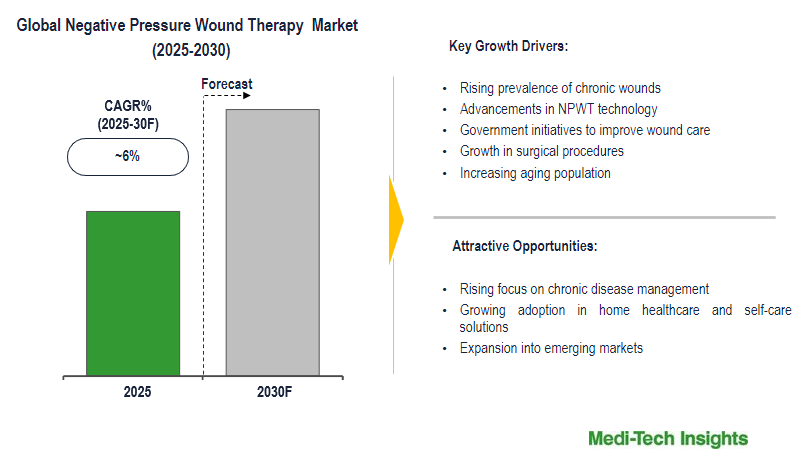
To learn more about this report, download the PDF brochure
Rising prevalence of chronic wounds boosts market growth
Globally, a significant number of individuals suffer from chronic or complex wounds that are difficult to heal, often resulting in severe pain and hardship. In recent years, chronic wounds have been described as a "silent epidemic" due to their rising incidence. This increase is largely driven by an aging population and a corresponding rise in comorbidities and lifestyle-related conditions such as diabetes, obesity, venous hypertension, and peripheral vascular diseases.
Chronic wounds pose serious challenges, including prolonged healing times, significant economic burdens, diminished quality of life, higher infection risks, and impacts on mobility and functionality. According to an article published by Wound Asia, approximately 1–2% of the population in developed countries suffers from chronic wounds at any given time. With an aging population, the prevalence of chronic wounds is expected to grow significantly. By 2025, the number of people living with diabetes worldwide is projected to exceed 400 million, with the largest increases occurring in Asia, Africa, and South America. NPWT has demonstrated effectiveness in managing chronic wounds. By applying negative pressure to the wound, NPWT facilitates the healing process through mechanisms such as stimulating granulation tissue and angiogenesis, reducing edema, and modulating matrix metalloproteinases. Additionally, NPWT improves blood flow and minimizes bacterial colonization within chronic wounds, making it a valuable tool in addressing this growing healthcare concern.
Technological advancement in NPWT drives market growth
Advancements in NPWT technology have greatly improved its effectiveness, ease of use, and versatility in various clinical settings. These innovations are focused on enhancing patient outcomes, optimizing treatment processes, and broadening accessibility. Key areas of progress include:
- Portable NPWT devices: Advances in miniaturization and portability have made NPWT devices more user-friendly and convenient. Lightweight, portable designs allow patients to maintain their daily routines while receiving treatment, leading to improved patient experiences, greater treatment adherence, and better overall outcomes.
- Single-use and disposable NPWT systems: Cost-effective and easy-to-use disposable NPWT devices are particularly suited for short-term use in outpatient and home care settings. These systems simplify treatment while maintaining effectiveness, making them ideal for various care environments.
- Smart NPWT systems: Modern NPWT systems now feature sensors that monitor critical wound-healing parameters such as pressure levels, fluid output, and temperature. These data-driven insights enable healthcare providers to track wound progress and make informed decisions. Advancements in artificial intelligence (AI) are set to revolutionize NPWT further, using data to guide therapy decisions and refine treatment protocols
- Infection Control Innovations: Newly designed NPWT systems prioritize infection control by incorporating fully enclosed systems that securely contain exudates, reducing the risk of contamination and pathogen exposure during treatment
- Telemedicine Integration: The integration of NPWT devices with telehealth platforms enables remote consultation, monitoring, and therapy adjustments. This is particularly beneficial for patients in rural or underserved areas, ensuring they receive consistent, high-quality care without frequent visits to healthcare facilities.
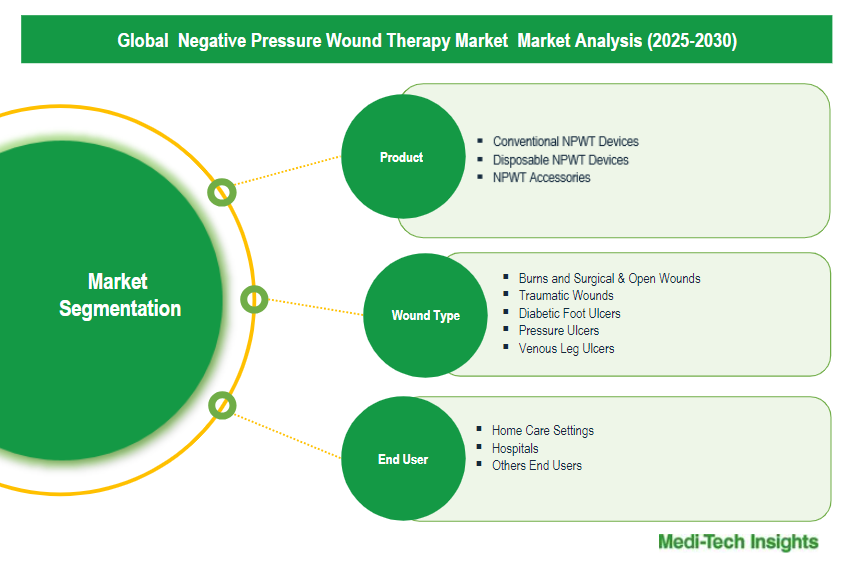
To learn more about this report, download the PDF brochure
Competitive Landscape Analysis
The global NPWT market is marked by established and emerging market players such as 3M (Acelity L.P. Inc.); ATMOS MedizinTechnik GmbH & Co. KG; Cardinal Health.; ConvaTec Group Plc.; DeRoyal Industries, Inc.; Devon International Group; Investor AB (Mölnlycke Health Care AB); Olle Larsson Holding AG (Medela AG); Smith & Nephew Plc.; and Talley Group Ltd.; among others. Some of the key strategies adopted by market players include new product development, strategic partnerships and collaborations, and investments.
Report Scope
| Report Metric | Details |
| Base Year Considered | 2024 |
| Historical Data | 2023 - 2024 |
| Forecast Period | 2025 - 2030 |
| Growth Rate | ~6% |
| Market Drivers |
|
| Attractive Opportunities |
|
| Segment Scope | Product, Wound Type, and End User |
| Regional Scope |
|
| Key Companies Mapped | 3M (Acelity L.P. Inc.); ATMOS MedizinTechnik GmbH & Co. KG; Cardinal Health.; ConvaTec Group Plc.; DeRoyal Industries, Inc.; Devon International Group; Investor AB (Mölnlycke Health Care AB); Olle Larsson Holding AG (Medela AG); Smith & Nephew Plc.; and Talley Group Ltd. (part of Direct Healthcare Group (DHG)) |
| Report Highlights | Market Size & Forecast, Growth Drivers & Restraints, Trends, Competitive Analysis |
Market Segmentation
This report by Medi-Tech Insights provides the size of the global negative pressure wound therapy market at the regional- and country-level from 2023 to 2030. The report further segments the market based on product, wound type, and end user.
-
Market Size & Forecast (2023-2030), By Product, USD Million
- Conventional NPWT Devices
- Disposable NPWT Devices
- NPWT Accessories
-
Market Size & Forecast (2023-2030), By Wound Type, USD Million
- Burns and Surgical & Open Wounds
- Traumatic Wounds
- Diabetic Foot Ulcers
- Pressure Ulcers
- Venous Leg Ulcers
-
Market Size & Forecast (2023-2030), By End User, USD Million
- Home Care Settings
- Hospitals
- Other End Users
-
Market Size & Forecast (2023-2030), By Region, USD Million
- North America
- US
- Canada
- Europe
- UK
- Germany
- Italy
- Spain
- Rest of Europe
- Asia Pacific
- China
- India
- Japan
- Rest of Asia Pacific
- Latin America
- Middle East & Africa
- North America
Key Strategic Questions Addressed
- What is the market size & forecast of the NPWT market?
- What are the historical, present, and forecasted market shares and growth rates of various segments and sub-segments of the NPWT market?
- What are the key trends defining the market?
- What are the major factors impacting the market?
- What are the opportunities prevailing in the market?
- Which region has the highest share in the global market? Which region is expected to witness the highest growth rate in the next 5 years?
- Who are the major players operating in the market?
- What are the key strategies adopted by players?
- Introduction
- Introduction
- Market Scope
- Market Definition
- Segments Covered
- Regional Segmentation
- Research Timeframe
- Currency Considered
- Study Limitations
- Stakeholders
- List of Abbreviations
- Key Conferences and Events (2025-2026)
- Research Methodology
- Secondary Research
- Primary Research
- Market Estimation
- Bottom-Up Approach
- Top-Down Approach
- Market Forecasting
- Executive Summary
- Negative Pressure Wound Therapy Market Snapshot (2025-2030)
- Segment Overview
- Regional Snapshot
- Competitive Insights
- Market Overview
- Market Dynamics
- Drivers
- Rising prevalence of chronic wounds
- Advancements in NPWT technology
- Government initiatives to improve wound care
- Growth in surgical procedures
- Increasing aging population
- Restraints
- Complications may arise that necessitate discontinuing of negative pressure wound therapy (NPWT)
- Limited awareness in emerging markets
- Opportunities
- Rising focus on chronic disease management
- Growing adoption in home healthcare and self-care solutions
- Expansion into emerging markets
- Key Market Trends
- Rising adoption of cost-effective, easy-to-use disposable NPWT devices
- Increased focus on infection control
- Growing integration with digital health technologies
- Development of smart NPWT devices
- Unmet Market Needs
- Industry Speaks
- Global Negative Pressure Wound Therapy Market Size & Forecast (2023-2030), By Product USD Million
- Introduction
- Conventional NPWT Devices
- Disposable NPWT Devices
- NPWT Accessories
- Global Negative Pressure Wound Therapy Market Size & Forecast (2023-2030), By Wound Type USD Million
- Introduction
- Burns and Surgical & Open Wounds
- Traumatic Wounds
- Diabetic Foot Ulcers
- Pressure Ulcers
- Venous Leg Ulcers
- Global Negative Pressure Wound Therapy Market Size & Forecast (2023-2030), By End User USD Million
- Introduction
- Home Care Settings
- Hospitals
- Others End Users
- Global Negative Pressure Wound Therapy Market Size & Forecast (2023-2030), By Region, USD Million
- Introduction
- North America Negative Pressure Wound Therapy Market Size & Forecast (2023-2030), By Country, USD Million
- US
- Market Size & Forecast, By Product (USD Million)
- Market Size & Forecast, By Wound Type (USD Million)
- Market Size & Forecast, By End User (USD Million)
- Canada
- Market Size & Forecast, By Product (USD Million)
- Market Size & Forecast, By Wound Type (USD Million)
- Market Size & Forecast, By End User (USD Million)
- US
- Europe Negative Pressure Wound Therapy Market Size & Forecast (2023-2030), By Country, USD Million
- UK
- Market Size & Forecast, By Product (USD Million)
- Market Size & Forecast, By Wound Type (USD Million)
- Market Size & Forecast, By End User (USD Million)
- Germany
- Market Size & Forecast, By Product (USD Million)
- Market Size & Forecast, By Wound Type (USD Million)
- Market Size & Forecast, By End User (USD Million)
- Italy
- Market Size & Forecast, By Product (USD Million)
- Market Size & Forecast, By Wound Type (USD Million)
- Market Size & Forecast, By End User (USD Million)
- Spain
- Market Size & Forecast, By Product (USD Million)
- Market Size & Forecast, By Wound Type (USD Million)
- Market Size & Forecast, By End User (USD Million)
- Rest of Europe
- Market Size & Forecast, By Product (USD Million)
- Market Size & Forecast, By Wound Type (USD Million)
- Market Size & Forecast, By End User (USD Million)
- UK
- Asia Pacific (APAC) Negative Pressure Wound Therapy Market Size & Forecast (2023-2030), By Country, USD Million
- China
- Market Size & Forecast, By Product (USD Million)
- Market Size & Forecast, By Wound Type (USD Million)
- Market Size & Forecast, By End User (USD Million)
- Japan
- Market Size & Forecast, By Product (USD Million)
- Market Size & Forecast, By Wound Type (USD Million)
- Market Size & Forecast, By End User (USD Million)
- India
- Market Size & Forecast, By Product (USD Million)
- Market Size & Forecast, By Wound Type (USD Million)
- Market Size & Forecast, By End User (USD Million)
- Rest of Asia Pacific
- Market Size & Forecast, By Product (USD Million)
- Market Size & Forecast, By Wound Type (USD Million)
- Market Size & Forecast, By End User (USD Million)
- China
- Latin America (LATAM) Negative Pressure Wound Therapy Market Size & Forecast (2023-2030), USD Million
- Market Size & Forecast, By Product (USD Million)
- Market Size & Forecast, By Wound Type (USD Million)
- Market Size & Forecast, By End User (USD Million)
- Middle East & Africa (MEA) Negative Pressure Wound Therapy Market Size & Forecast (2023-2030), USD Million
- Market Size & Forecast, By Product (USD Million)
- Market Size & Forecast, By Wound Type (USD Million)
- Market Size & Forecast, By End User (USD Million)
- Competitive Landscape
- Key Players and their Competitive Positioning
- Key Player Comparison
- Segment-wise Player Mapping
- Market Share Analysis (2024)
- Company Categorization Matrix
- Dominants/Leaders
- New Entrants
- Emerging Players
- Innovative Players
- Key Strategies Assessment, By Player (2022-2024)
- New Product Launches
- Partnerships, Agreements, & Collaborations
- Mergers & Acquisitions
- Geographic Expansion
- Key Players and their Competitive Positioning
- Company Profiles*
(Business Overview, Financial Performance**, Products Offered, Recent Developments)
- 3M (Acelity L.P. Inc.)
- Smith & Nephew
- ATMOS MedizinTechnik GmbH & Co. KG
- Cardinal Health.
- ConvaTec Group Plc.
- DeRoyal Industries, Inc.
- Devon International Group
- Investor AB (Mölnlycke Health Care AB)
- Olle Larsson Holding AG (Medela AG)
- Smith & Nephew Plc.
- Other Prominent Players
Note: *Indicative list
**For listed companies
The study has been compiled based on extensive primary and secondary research.
Secondary Research (Indicative List)
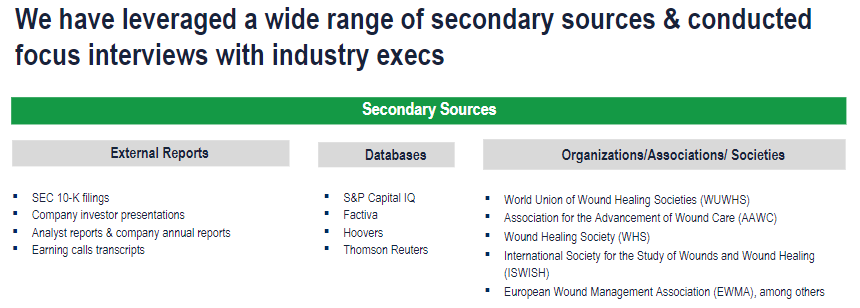
Primary Research
To validate research findings (market size & forecasts, market segmentation, market dynamics, competitive landscape, key industry trends, etc.), extensive primary interviews were conducted with both supply and demand-side stakeholders.
Supply Side Stakeholders:
- Senior Management Level: CEOs, Presidents, Vice-Presidents, Directors, Chief Technology Officers, Chief Commercial Officers
- Mid-Management Level: Product Managers, Sales Managers, Brand Managers, R&D Managers, Business Development Managers, Consultants
Demand Side Stakeholders:
- Stakeholders from Hospitals, Home Care Settings, and Others
Breakdown of Primary Interviews
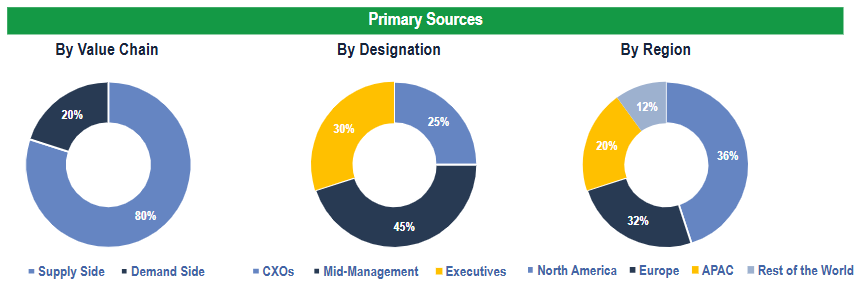
Market Size Estimation
Both ‘Top-Down & Bottom-Up Approaches’ were used to derive market size estimates and forecasts.
Data Triangulation
Research findings derived through secondary sources & internal analysis were validated with Primary Interviews, the Internal Knowledge Repository, and Company’s Sales Data.

